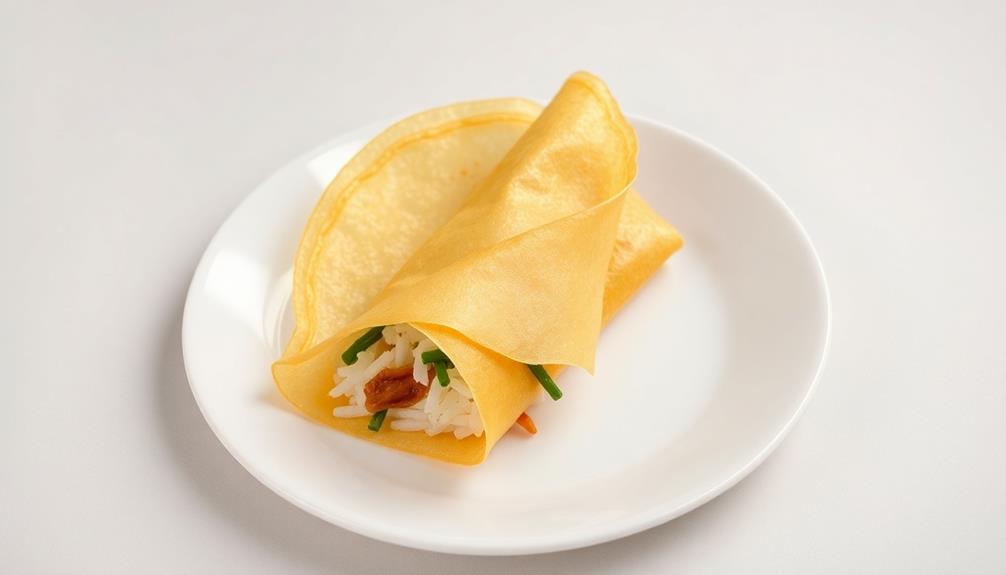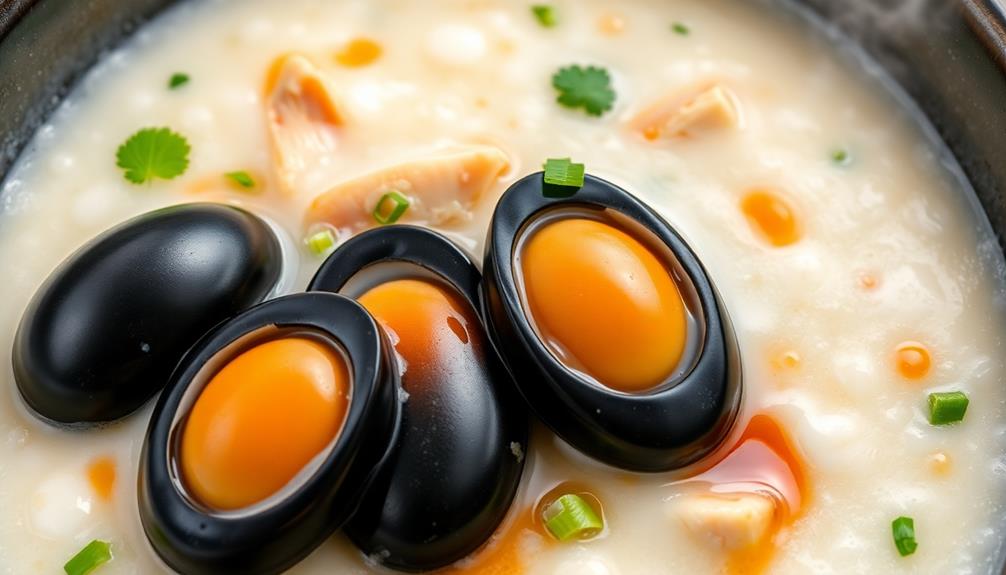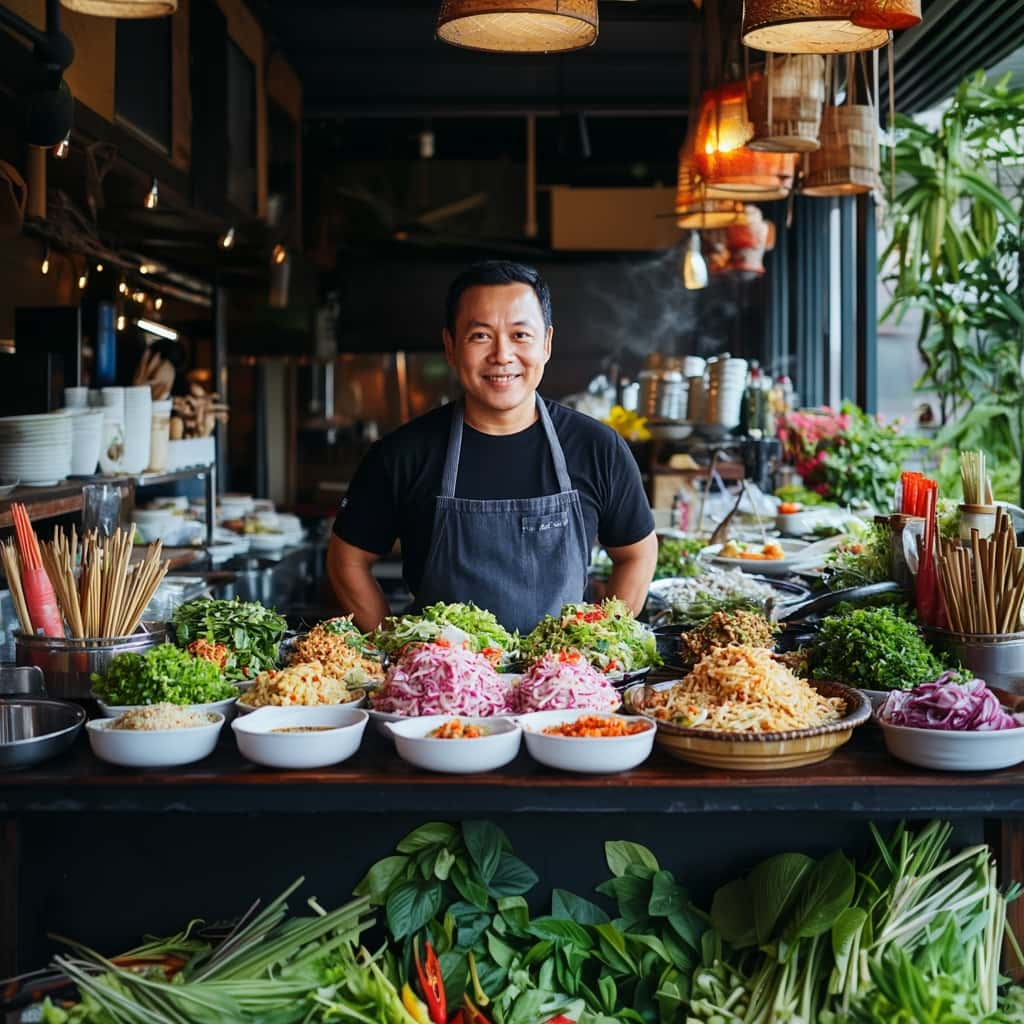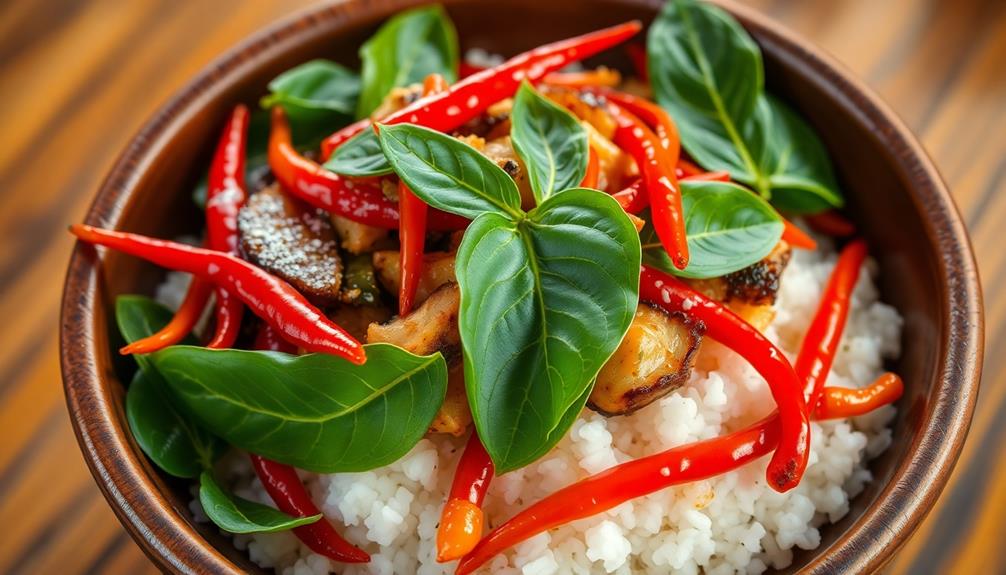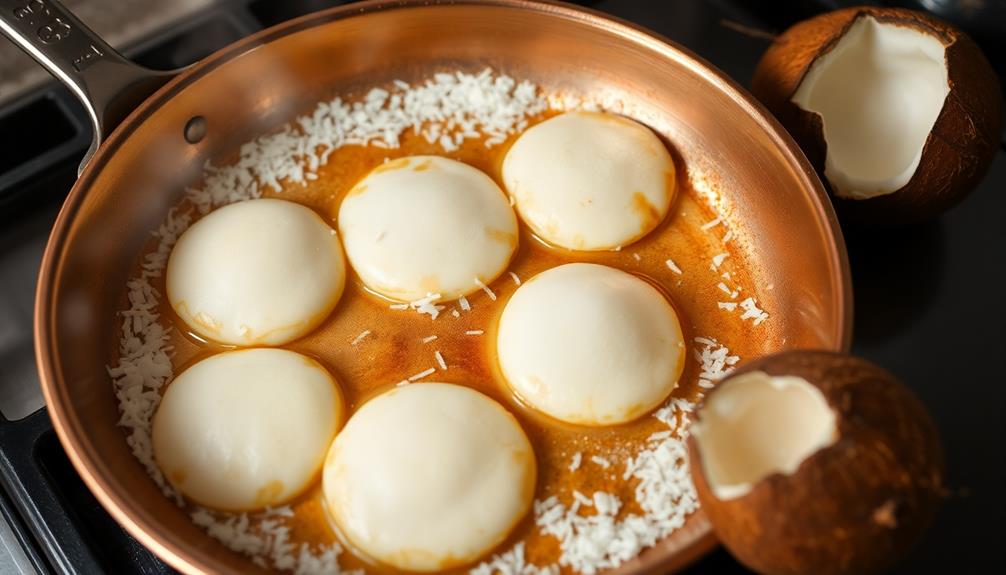Khanom Buang, Thailand's beloved street food delicacy, has a rich history dating back to palace chefs showcasing their culinary skills. These Thai crepes boast a crispy outer layer and soft, flavorful filling – blending sweet and savory tastes to delight diverse palates. The batter's simple ingredients, like coconut milk and flour, come together to create an enticing texture. As you savor each bite, you'll uncover regional variations and unique vendor touches that highlight the country's culinary creativity. Discover the fascinating story and preparation of this treasured Thai treat – there's much more to explore. And while you’re exploring Thai street food, don’t miss out on the opportunity to savor another beloved dish – thaistyle boat noodles. This hearty and flavorful soup is a true representation of Thailand’s rich culinary heritage, with its robust broth and tender meat or seafood. Each bowl is a testament to the country’s diverse flavors and culinary ingenuity, making it a must-try for any food enthusiast visiting the bustling streets of Thailand.
Key Takeaways
- Khanom Buang are Thai crepes, a beloved street food delicacy with a crispy outer layer and soft, sweet or savory fillings.
- The crepes originated from palace chefs and have evolved to reflect local tastes, with each vendor adding a unique touch.
- Khanom Buang are typically made from a batter of all-purpose flour, tapioca flour, coconut milk, and palm sugar, cooked on a hot griddle.
- Sweet variations often include coconut cream and sugar, while savory options may feature Thai herbs and proteins.
- Khanom Buang are commonly enjoyed during festivals and celebrations, symbolizing Thai culinary creativity and community.
History
The creation of Khanom Buang is believed to have originated from the skilled hands of palace chefs, who perfected the art of crafting these delicate treats.
Over time, the recipe and techniques spread throughout Thailand, allowing the dish to evolve and adapt to local preferences. Today, you can find Khanom Buang vendors in bustling markets and street corners, each offering their unique spin on this timeless delicacy.
The process of making Khanom Buang is a true testament to Thai culinary expertise. It requires careful batter preparation, precise cooking on a specialized griddle, and the skilled folding technique that gives the crepe its signature shape.
Mastering this process takes years of practice, ensuring each Khanom Buang is a work of edible art.
Recipe
Khanom Buang is a traditional Thai sweet snack that features a delicate, crispy shell filled with a savory-sweet coconut custard. This versatile treat can be enjoyed as a dessert or a midday snack, making it a beloved part of Thai cuisine.
The key to a successful Khanom Buang lies in the balance of textures and flavors. The crisp, golden shell provides a satisfying crunch, while the creamy, aromatic coconut filling offers a smooth and indulgent contrast.
- 1 cup all-purpose flour
- 1/4 cup tapioca flour
- 1/2 teaspoon salt
- 1 cup coconut milk
- 1/2 cup palm sugar, grated
- 2 eggs, lightly beaten
- 1/4 cup desiccated coconut
To prepare Khanom Buang, begin by mixing the all-purpose flour, tapioca flour, and salt in a bowl. Gradually add the coconut milk, stirring constantly to prevent lumps from forming. Heat the mixture over medium heat, stirring frequently, until it thickens into a smooth batter.
Transfer the batter to a piping bag fitted with a small round tip. Preheat a non-stick pan or griddle over medium heat. Pipe the batter onto the hot surface, creating small, round shells. Cook until the edges turn golden brown, then carefully flip and cook the other side until crisp. Remove the shells from the pan and set aside to cool.
In a separate bowl, whisk together the palm sugar, eggs, and desiccated coconut to create the coconut filling. Spoon a small amount of the filling into the center of each Khanom Buang shell. Serve the filled Khanom Buang immediately, as the crisp shells can become soft over time. Enjoy this delightful Thai treat!
Cooking Steps
First, you'll need to prepare the batter by mixing all the ingredients together.
Next, heat up the pan and pour the batter onto it.
Step 1. Prepare Batter by Mixing Ingredients
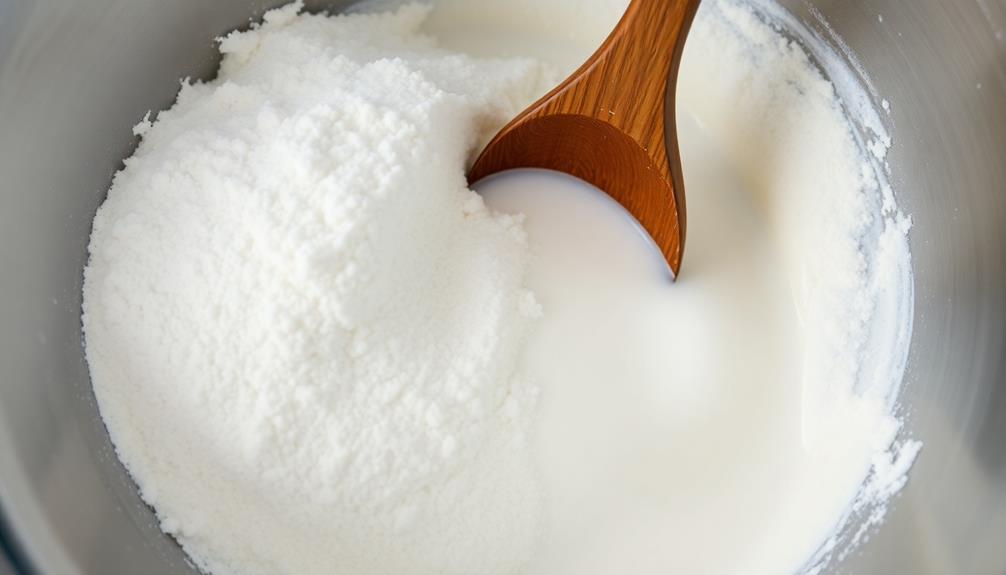
Begin by combining the flour, rice flour, and sugar in a mixing bowl. Use a whisk to mix these dry ingredients together until they're well incorporated.
Next, crack the eggs into the bowl and use the whisk to beat them lightly. Slowly pour in the coconut milk and water while continuing to whisk the batter. Mix everything together until it has a smooth, pourable consistency.
Now, let's test the batter. Heat a small non-stick skillet over medium heat and lightly grease the surface. Pour about 2-3 tablespoons of batter into the pan, tilting it to spread the batter into a thin, round crepe.
Cook for 1-2 minutes until the edges start to curl up and the center is set. Carefully flip the crepe and cook for another 30 seconds to 1 minute on the other side. Transfer the cooked crepe to a plate and repeat with the remaining batter, greasing the pan as needed.
Your khanom buang batter is now ready to be filled and rolled up.
Step 2. Heat the Pan
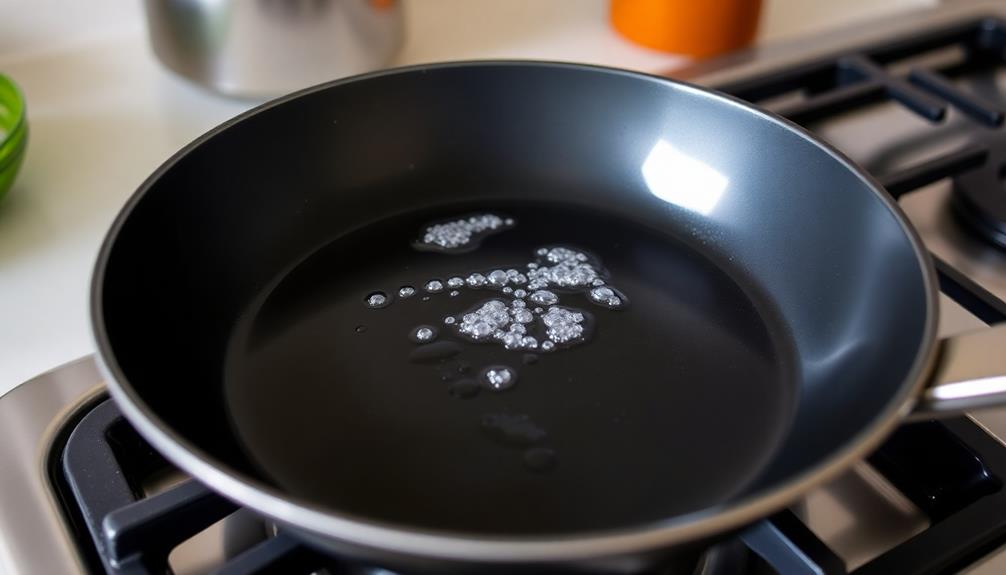
To cook the khanom buang, you'll first need to heat up a small non-stick skillet over medium heat.
Once the pan is hot, you can add a small amount of oil or butter to coat the surface. Be careful not to let the pan get too hot, as that can cause the crepes to burn.
Next, scoop about 2-3 tablespoons of the batter into the center of the pan. Use the back of a spoon to quickly spread the batter into a thin, round crepe.
Cook the crepe for 1-2 minutes, or until the edges start to turn golden brown. Gently loosen the edges with a spatula, then flip the crepe and cook for another 30 seconds to 1 minute on the other side.
Once the crepe is cooked, transfer it to a plate and repeat the process with the remaining batter, adding more oil or butter to the pan as needed.
Be sure to work quickly, as khanom buang crepes cook very fast.
Step 3. Pour Batter Onto Pan
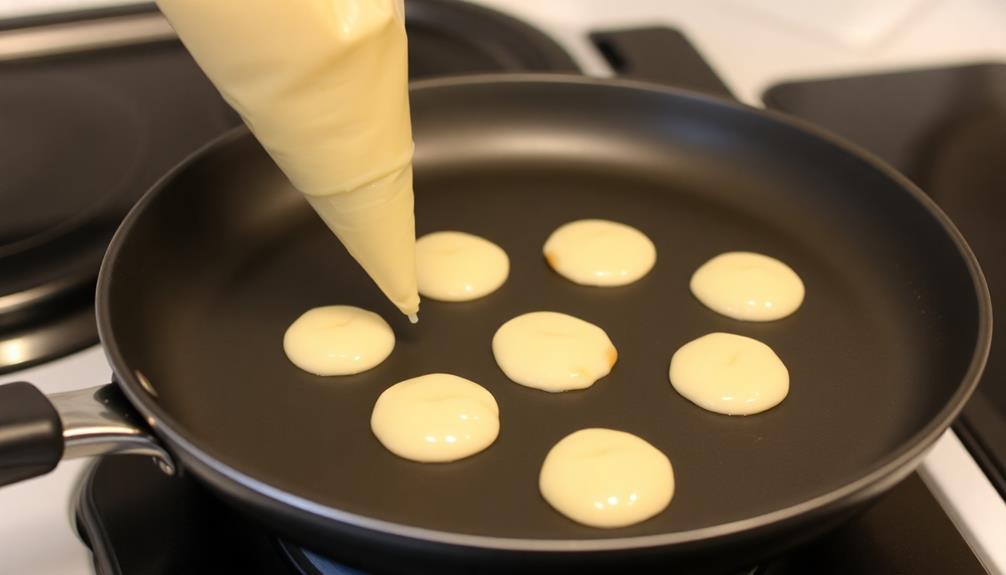
With the pan heated, it's time to pour the batter. Grab your ladle and carefully pour a small amount of the batter onto the center of the pan.
Use gentle, circular motions to spread the batter evenly, making sure it covers the entire surface. You'll want to pour just enough to create a thin, even layer – not too thick or too thin.
As the batter cooks, you'll see the edges start to lightly brown and the center become more set. This is your cue to gently flip the crepe over using a spatula.
Be careful not to tear or break the delicate crepe. Cook the other side for about a minute until it's lightly golden.
Now, transfer the cooked crepe to a plate. Repeat this process, pouring and spreading the batter, then flipping and cooking, until you've used up all the batter.
Remember to keep the pan well-greased between each crepe to prevent sticking.
Step 4. Flip the Crepe Gently
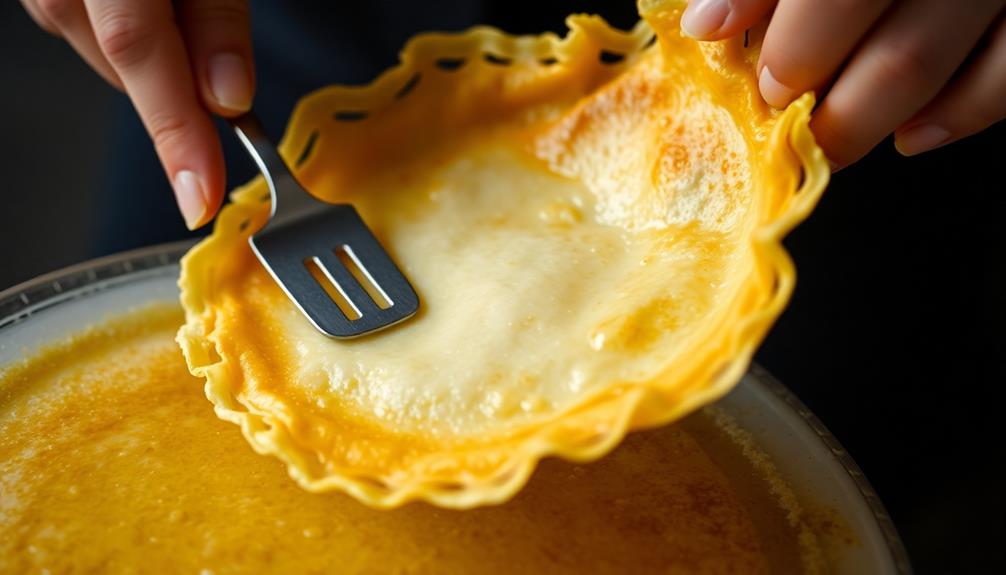
Gently slide the spatula under the crepe, taking care not to tear it. Slowly lift the edge and peek underneath to check if it's golden brown.
Once you're satisfied with the color, swiftly but gently flip the crepe over. The uncooked side should now be facing down, sizzling and bubbling. Let it cook for another minute or so, keeping a close eye on it.
When the crepe is cooked through, it should be pliable yet sturdy enough to hold its shape. Slide the spatula fully under the crepe and lift it out of the pan.
Be mindful not to let it fold or crease too much in the process. Place the crepe on a plate or cooling rack, and repeat the process with the remaining batter.
Remember to adjust the heat if the crepe is browning too quickly or not cooking evenly. With a little practice, you'll be flipping these delicate Thai crepes like a pro.
Step 5. Serve the Crepe Immediately
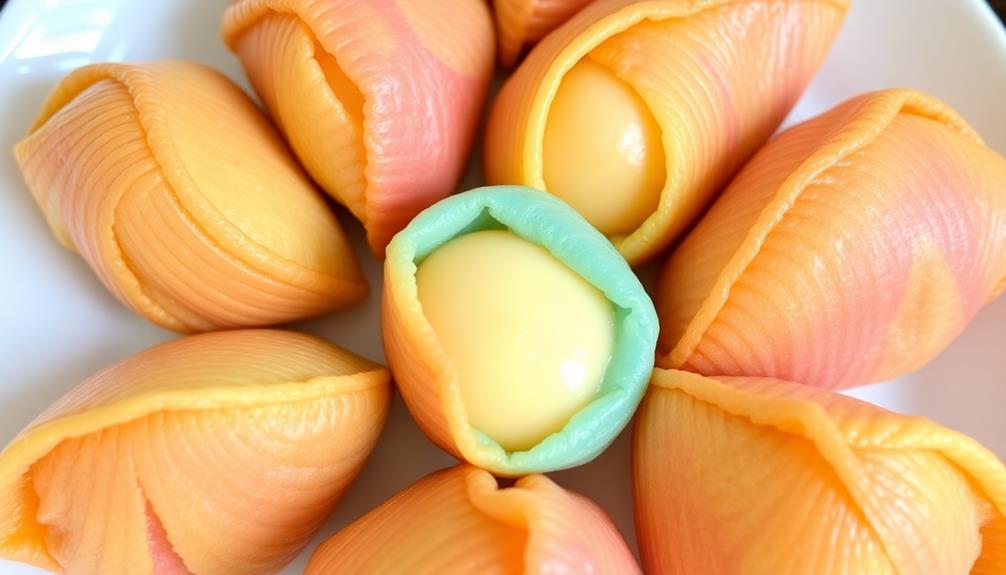
Serving the crepes immediately is key to enjoying their delicate, warm texture. As soon as you've gently flipped the crepe and it's cooked through, transfer it to a plate or serving platter. The crepes are best eaten straight away, while they're still piping hot. Letting them sit will cause them to stiffen and lose that lovely, soft mouthfeel.
Arrange the crepes in a stack or fan them out attractively on the plate. You can serve them plain or top them with your desired fillings and garnishes. Some popular options include sweet coconut, savory chicken, or fresh fruits and herbs. Drizzle on a bit of sweetened condensed milk or honey for an extra touch of richness.
Encourage your guests to dig in right away and savor each bite. The delicate, gossamer-thin crepes are meant to be enjoyed at the peak of freshness. Their flavors and textures will delight the senses, making every mouthful a true delight.
Final Thoughts
Ultimately, khanom buang remain a beloved Thai delicacy, captivating taste buds with their delicate balance of sweet and savory flavors.
These delicate crepes have endured the test of time, passing down through generations and evolving to suit modern palates. While traditionalists may prefer the classic fillings, the versatility of khanom buang allows for endless creativity, from savory spiced chicken to sweet coconut custard.
You'll find these charming treats sold by street vendors and in local markets, each vendor offering their own unique spin.
Whether you're a seasoned khanom buang enthusiast or new to this Thai treasure, the joy of discovering your perfect flavor combination is half the fun.
Frequently Asked Questions
What Is the Origin of the Name "Khanom Buang"?
The name "khanom buang" likely derives from its distinctive appearance, as it looks like a "buang" or small boat. This Thai street food has become a beloved local delicacy, reflecting its rich cultural heritage.
How Long Does It Take to Prepare Khanom Buang?
Preparing this delicate treat takes some time, but the effort is well worth it. You'll need around 30-45 minutes to whip up a batch, from mixing the batter to perfectly shaping each crepe.
Can Khanom Buang Be Made Gluten-Free or Vegan?
Yes, you can make this dish gluten-free or vegan. Use gluten-free flour and plant-based milk for the crepe batter, and opt for vegan fillings like coconut, mung beans, or fruit preserves instead of the traditional egg and shredded coconut.
How Long Can Khanom Buang Be Stored After Preparation?
Once prepared, you can typically store the khanom buang for up to 2-3 days in the refrigerator. Keep them in an airtight container to maintain their freshness. However, they're best enjoyed as soon as possible for the ideal taste and texture.
Are There Any Variations or Regional Differences in Khanom Buang?
Are there variations or regional differences in this traditional dish? Absolutely! Depending on the local ingredients and cooking methods, you'll find all sorts of unique takes on this classic treat across Thailand.
